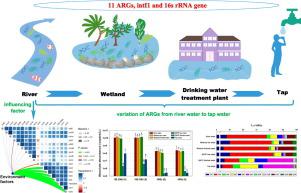Science of the Total Environment ( IF 8.2 ) Pub Date : 2020-06-29 , DOI: 10.1016/j.scitotenv.2020.140592 Juan Yang 1 , Hong Wang 2 , Dustin James Roberts 1 , Hao-Nan Du 1 , Xin-Feng Yu 3 , Ning-Zheng Zhu 4 , Xiang-Zhou Meng 1

|
Antibiotic resistance genes (ARGs) raise public concern as emerging contaminants. The abundance and variation of 11 ARGs, intI1 and 16S rRNA gene were deciphered using quantitative PCR (qPCR) in two drinking water treatment systems that include river, wetland, drinking water treatment plants (DWTPs) and tap water from the Yangtze River Delta. The influencing factors for ARG abundance in river water were also explored. All investigated genes were detected in river water and there was no significant difference between the two systems, with sulfonamide ARGs occupying the highest abundance. Temperature had a significant effect on the ARG distribution based on permutational multivariate analysis of variance (PERMANOVA). Further Spearman analysis demonstrated that temperature was strongly correlated with the abundance of sul1, sul2, tetA and tetC, and these genes were significantly correlated with environmental factors (including temperature, total organic carbon (TOC) and dissolved oxygen (DO)). Considering the frequency and abundance of ARGs, as well as their correlation with other genes, sul1, sul2, tetA and tetC could be used as indicators of ARGs in river water. No significant reduction was noted for the absolute abundance of ARGs from river water to wetland water. Principle coordinates analysis (PCoA) combined with PERMANOVA revealed that drinking water treatment was responsible for reducing 16S rRNA gene and ARG abundance resulting in 3-log reductions. However, it should be noted that after transportation of distribution pipeline, both 16S rRNA gene and ARGs still detected in tap water, which indicated persistence of ARGs and will require further research.
中文翻译:

长江三角洲从河水到自来水的抗生素抗性基因的持久性。
抗生素抗性基因(ARG)作为新兴污染物引起了公众的关注。11个ARG的丰度和变异,整数在两个饮用水处理系统中,使用定量PCR(qPCR)对I1和16S rRNA基因进行了解密,该系统包括河流,湿地,饮用水处理厂(DWTP)和长江三角洲的自来水。还探讨了河水中ARG丰度的影响因素。在河水中检测到所有被调查的基因,两个系统之间没有显着差异,其中磺酰胺类ARG的丰度最高。基于方差的排列多变量分析(PERMANOVA),温度对ARG分布有重大影响。进一步的Spearman分析表明温度与sul1,sul2,tetA和tetC的丰度强烈相关,并且这些基因与环境因素(包括温度,总有机碳(TOC)和溶解氧(DO))显着相关。考虑到ARGs的频率和丰度以及它们与其他基因sul1,sul2,tetA和tetC的相关性可用作河流水中ARGs的指标。从河水到湿地水的ARG的绝对丰度没有显着降低。主坐标分析(PCoA)与PERMANOVA的结合表明,饮用水处理导致16S rRNA基因减少和ARG丰度降低,导致3-log降低。但是,应注意的是,在输配管道运输后,自来水中仍检测到16S rRNA基因和ARG,这表明ARG的持续存在,需要进一步研究。











































 京公网安备 11010802027423号
京公网安备 11010802027423号